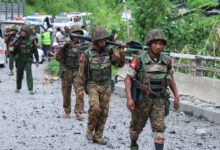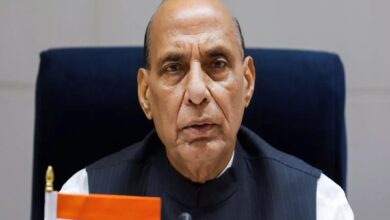30 More Myanmar Soldiers Repatriated From Mizoram Amidst Ongoing Crisis

- A lot of illegal drugs and narcotics have been found on people who come, so we are keeping a close eye on drug dealers.
- The unfenced 1,643-km border between India and Myanmar is being watched over by the Assam Rifles, which has increased its patrols along the border.
About 30 Army soldiers who came to Mizoram after pro-democracy forces took over their military camps were sent back to Myanmar.
Armed pro-democracy forces took over the camps of 30 soldiers, including an officer, at Motupi in Chin state on Tuesday. The soldiers then ran away to Tuipang village in Mizoram’s Siaha district. The 30 soldiers were flown from Mizoram’s Siaha district to Manipur’s Moreh town on Wednesday afternoon by two Indian Air Force (IAF) helicopters. They were then given to Myanmar’s military authorities.
He said that the Indian government gave the 30 soldiers to officers in the Myanmar Army at Tamu, which is across the border from Moreh, after going through all the necessary steps, which included a biometric process.
It is 110 km south of Imphal, in the border town of Moreh.
Since November 13, 74 soldiers and officers from the Myanmar Army have fled to India in several stages after their camps in Chin state were taken over by the Chin National Defense Force (CNDF), which is the armed branch of the Chin National Organization (CNO).
The soldiers were caught by the Mizoram police in the Champhai district and then given to the Assam Rifles. The border between Moreh and Tamu was used to bring all 74 soldiers back to Myanmar.
The Eastern Army Commander, Lt. Gen. Rana Pratap Kalita, recently said that when fighting gets tough in Myanmar, villagers cross over to the Indian side and then slowly come back. Villages that are looking for refugees are not stopped.
“Any instability in our neighborhood is not in our interest, it affects us because we share a border,” Kalita said. The problem between India and Myanmar is made worse by the country’s rough terrain and geography.
He said, “Because people are of the same ethnicity, the border is very porous, even with the Free Movement Regime (FMR) in place.” Even though FMR was stopped during the COVID, people are used to it now. It gets hard to tell the difference between people from our country and people from other countries. People near the border cross over when fighting between the Myanmar army and pro-democracy forces gets bad. Some go back, but others stay put.
He also said, “A small group of people sought refuge in Manipur, and a larger group did so in Mizoram.” There is a process that is followed after consulting with the state government. Whenever they want to go back, they are sent back, but it is made very clear that armed cadres are not allowed to come in. Find out who these people are, record their biometrics, set up camps, and keep them in one place. They are checked against records to make sure they are not part of any rebel groups. A lot of illegal drugs and narcotics have been found on people who come, so we are keeping a close eye on drug dealers.
He also said, “Even when members of the Myanmar army are looking for refuge, we are allowed to take them to the Moreh border and hand them over to the Myanmar government after taking away their weapons and making sure they have the right IDs.” People in the village who are fleeing violence are not stopped.
Already, 32,000 people from Myanmar, mostly women and children, have taken refuge in the northeastern state. The vast majority of refugees stay in relief camps and government buildings. Many others stay with relatives, and a large number of Myanmarese have rented homes.
Champhai, Siaha, Lawngtlai, Serchhip, Hnahthial, and Saitual are the six districts in eastern Mizoram. They share a 510-km-long, mountainous border with Chin state in Myanmar that is not fenced in. The unfenced 1,643-km border between India and Myanmar is being watched over by the Assam Rifles, which has increased its patrols along the border.






Facebook Comments